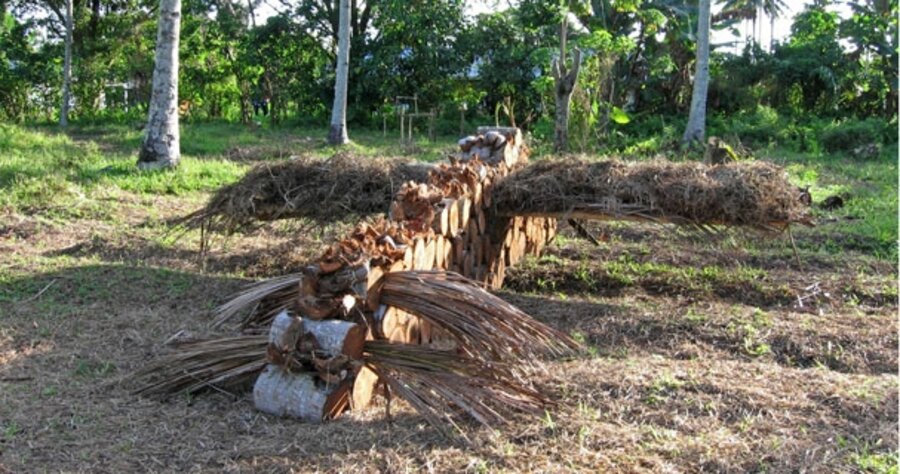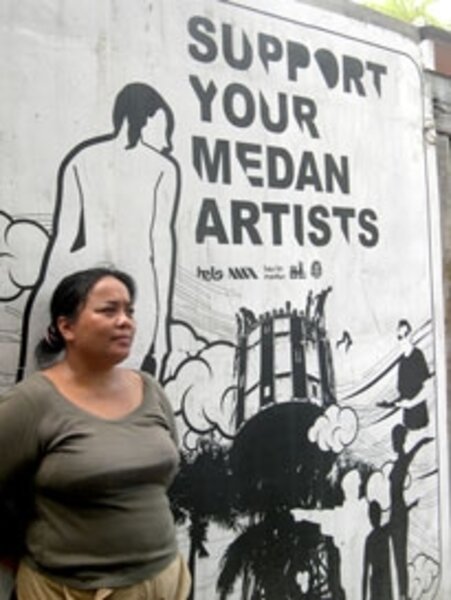An Indonesian artist uses her canvas to unite a nation
Loading...
| Jakarta, Indonesia
At first, Grace Siregar responded to the political upheaval of 1998 in her native Indonesia with artistic shock. Suharto, the repressive strongman who ruled for more than 30 years, was gone.
In the streets, Indonesians were turning on each other, neighbor on neighbor, ethnic group on ethnic group, to vent their frustration over a generation of political repression and recent economic woe.
Siregar’s oil painting, “My Country,” begun that year while she was abroad in Holland, is a wall-length, sullen, black cloud. “We were famous for our kindness and then we changed to something else – demonic almost,” she says. “I was crying when I painted it.”
But a strange thing happened when she returned to Indonesia and visited East Timor, a restive province that had just suffered through a bloody struggle to win independence from Indonesia. There, Siregar was treated with a surprising tenderness by the ethnic Timorese who had every reason to hate her. Elsewhere in the country, a sense of gentility seemed to be holding on, too.
And so from the ashes of the upheaval came a new mission: to draw fractious groups back together – through art.
Since then, Siregar has been a sort of roving artistic reconciliation show, working to carve out new places for expression as the country explores its thresholds for tolerance in the post-Suharto era. She has gotten rural artists from warring religious groups to contribute to joint art installations in the eastern provinces of Maluku. She has invited a polyglot group of artists to contribute to her free-form gallery in Sumatra. She’s painted peace totems on freeway overpasses and asked diverse painters to depict the devastating Asian tsunami.
Siregar is a classically trained painter who has had works displayed in Indonesia’s National Gallery, but her calling now is helping the country to vent on canvas instead of at one another.
“The most important thing for me now is to make my art contribute to all of Indonesia,” she says. “I’ve had time to think about what I want, and this is what I want.”
•••
Her most successful work so far may be in North Maluku, in Indonesia’s historic eastern spice isles. Post-Suharto violence erupted there in 1999 after a fight between a bus rider and driver in the capital of Ambon swelled into attacks and reprisals between Muslims and Christians. A separatist movement gained new traction among the restless Christian minority.
By the time Siregar and her husband, filmmaker and aid worker Alexander Davey, arrived in 2003, the street battles had stopped but were still fresh in peoples’ minds. She noticed that street artists had been painting murals with reconciliation themes on the sides of old houses and market walls. She sought them out and encouraged them.
At the same time, Siregar, who once worked as a journalist in Europe, started a weekly show interviewing musicians and other performers on a Catholic-sponsored peace channel, Suara Paksi Buana.
After a year building up the cadre of local artists, she and other artists decided to push forward with a demonstrative peace installation, using local materials spread across a large coconut grove in the northern city of Tobelo.
“These guys who were just coconut farmers’ kids were doing the most amazing things,” says Siregar. “They didn’t have any training, but they were born to be artists.”
Hans Ririmasse, one of the artists, formed a circle out of sticks, and in each of four quadrants he fashioned colored and different-shaped figures from coconut wood. “Your Family, My Family,” he called it. “For me, this was really about making a statement that we can’t be separated by war or poverty or greed or hatred or many of the other things that have led to hostility here,” he says.
Siregar put her own piece, “Locust,” a Pterodactyl-sized model of the bug from coconut shells and trunks, alongside the others to commemorate another conflict farmers had faced recently from a devastating scourge of pests.
“The situation is good now and people are talking about developing the area together,” says Father Patrisius Anselmus Jeujanan, whose mission includes the radio station. “Culture and art have been media for the reconciliation.”
Siregar has since returned to her birthplace in the Sumatran city of Medan and opened a freewheeling gallery space called Tondi, or “life force” in the local Batak dialect. It is housed in a deliberately unassuming bungalow on the outskirts of the commercial district of Sumatra’s biggest city, not far from a Hindu temple, a Starbucks, and pork curry stands.
On a recent afternoon, two dozen photographs from local university students hung on the walls of Tondi, depicting garbage dumps and misty forested mountains and sepia-toned noodle-shop scenes. Siregar gabbed in her deep, giddy voice with the gallery steward, an elderly Indian-Indonesian woman.
Tondi features everything from one-woman performance art, drawings from street kids, and sculpture from established colleagues of Siregar’s. She’s had rap groups and even a pop band comprised of street artists. She likes to shake things up during religious holidays: If it’s a Muslim holy day, she might bring in Hindu and Christian artists.
The place is sort of like its founder, playful and profound. “The street kids’ work is free and vibrant and full of the agony and ecstasy of existence,” says Siregar. “That’s the kind of spirit we always want to maintain at Tondi.”
•••
Siregar’s artistic journeying started at the age of 6, when she began studying with a traveling, self-taught painter on the Sumatran island of Bangka. She also worked with a classically taught ceramacist in The Netherlands, and draws on Batak tribal motifs from her family’s homeland in North Sumatra. “Eclectic would be a good word,” she says of her influences.
Her work is unusual enough that not everyone accepts or appreciates it, especially in the more upscale confines of the capital of Jakarta. A few years ago, a reviewer in a Jakarta newspaper described some of her work as “unpleasant,” referring to an installation when she used excrement as part of a bathroom tableau.
Fellow Batak artist Dolorosa Sinaga, a well-known sculptor based in Jakarta, says Siregar’s installations can be edgy, as in “projects where she’ll place objects that take over a gallery space and you can’t get past.”
“But I’m proud of her,” Sinaga adds. “She dares to take risks, especially in establishing new traditions outside Java.”
And in seeking out new traditions throughout the fringes of Indonesia, Siregar seems to also be finding new people to work with and fresh ideas to pursue. Her latest planned installation venture involves taking several artists from North Sumatra by boat up to Maluku to commune and create new art with friends she worked with a few years ago.
“Jakarta friends are kind of puzzled when I talk about the work,” Siregar says. “But I say, ‘How many people are having this experience?’ This is a chance to make my work much richer.”
And, just maybe, the country.






